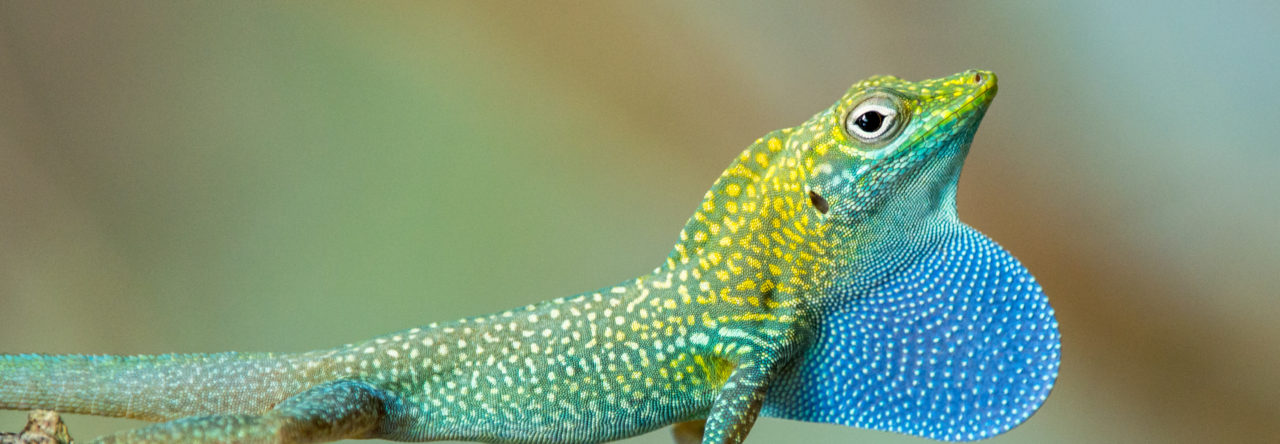
Anolis onca basking. Photo by Gabriel Ugueto.
The ecological niche is one of the most controversial concepts in ecology with a long history of debate about its definition and scope. Some authors have suggested that this concept should be abandoned (see for example McInerny & Etienne, 2012a,b,c), while others, including me, consider that this controversial history, and a plethora of definitions, should not preclude its use. However, it needs to be explicitly defined to known exactly we are talking about.
The ecological niche is understood as the set of environmental factors that allow a local population to persist without immigration from others sources (Hutchinson 1959). Some evolutionary ecologists have envisioned the ecological niche as a phenotypic extension of a species and therefore subject to natural selection and other evolutionary process. Based on this, in my doctoral dissertation, I evaluated whether the ecological niche (or more precisely, the climatic niche), as a population-level trait, can promote species diversification in Anolis lizards. Although there are several studies linking organismal and species’ level traits with speciation, there are few exploring this association in Anolis lizards.
Our study exploring this was recently published in the Journal of Biogeography (Velasco et al. 2016). Explicitly, we adopt Hutchinson’s niche definition using only coarse-grain variables (or the Grinnellian niche dimension; see Soberón 2007). To do this, we compiled an extensive occurrence database for 328 species with help of several colleagues. Using climatic layers from WorldClim database, we calculated a set of niche metrics for species and clades, including mean niche position (based on PCA analyses), niche breadth (based on Mahalanobis distances) and occupied niche space (as a proxy of climatic niche diversity).
We compared how climatic niche breadth and occupied niche space differ among regions (insular vs. mainland) and clades (Fig. 1 & 2). Mainland species and clades tend to exhibit larger niches than Caribbean clades and species (Fig. 1).

These differences were maintained after controlling for range size differences. We suggest that these differences are directly related to the available climatic space in each region. For instance, Caribbean islands exhibit a limited climatic space in comparison with mainland regions and therefore insular clades occupy all available climatic conditions in each island (Fig. 2). By contrast, mainland clades are more restricted to climatic conditions and therefore occupy only a portion of all available climatic conditions (Fig. 2).

We correlated these niche metrics with species diversification using a calibrated time tree. We found that anole clades occupying warmer and drier areas diversified more than clades occupying very humid and colder areas. In addition, anole clades with narrow niches tend to speciate more than clades with widespread niches (Fig. 3). Our findings suggest that climatic specialization has played a strong role in anole diversification with differences among insular and mainland settings.

It would be interesting to evaluate whether other traits (e.g., body size, geographical range size, or other Eltonian niche dimensions) also play a similar role on cladogenesis in Anolis lizards and evaluate their relative importance in diversification dynamics.
References
Hutchinson, G.E. (1957) Concluding remarks. Cold Spring Harbor Symposia on Quantitative Biology, 22, 415-427.
McInerny, G.J. & Etienne, R.S. (2012a) Ditch the niche ? is the niche a useful concept in ecology or species distribution modelling? J. Biogeogr., 39, 2096-2102.
McInerny, G.J. & Etienne, R.S. (2012b) Stitch the niche ? a practical philosophy and visual schematic for the niche concept. J. Biogeogr., 39, 2103-2111.
McInerny, G.J. & Etienne, R.S. (2012c) Pitch the niche ? taking responsibility for the concepts we use in ecology and species distribution modelling. J. Biogeogr, 39, 2112-2118.
Soberón, J. (2007) Grinnellian and Eltonian niches and geographic distributions of species. Ecology Letters, 10, 1115-1123.
Velasco, J. A., Martínez-Meyer, E., Flores-Villela, O., García A., Algar, A. C., Köhler, G. and Daza, J. M. (2016), Climatic niche attributes and diversification in Anolis lizards. J. Biogeogr., 43: 134-144. doi:10.1111/jbi.12627

















